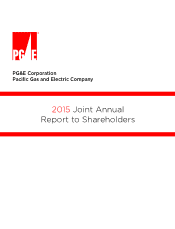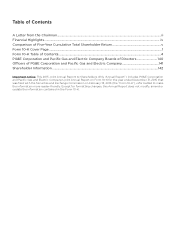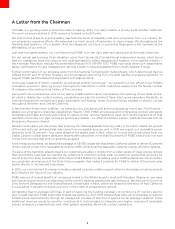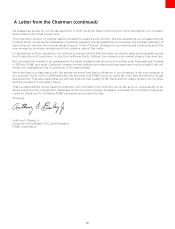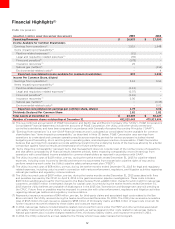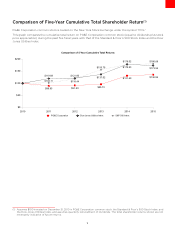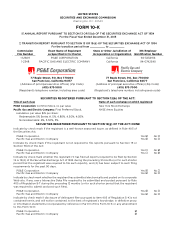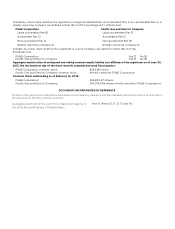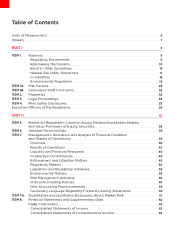PG&E 2015 Annual Report Download - page 4
Download and view the complete annual report
Please find page 4 of the 2015 PG&E annual report below. You can navigate through the pages in the report by either clicking on the pages listed below, or by using the keyword search tool below to find specific information within the annual report.
ii
A Letter from the Chairman
At PG&E, our guiding vision is to be the nation’s leading utility. Our daily mission is to help build a better California.
The work we accomplished in 2015 moved us forward on both fronts.
We took further steps to improve safety, reached new levels of reliability, and won recognition from our industry for
our emergency response eorts. We extended our track record of leadership on clean energy. We strengthened the
flexibility and resiliency of our system. And we sharpened our focus on achieving these gains while maintaining the
aordability of our service.
Last year’s progress adds to our confidence that PG&E is on the right path, and taking aim at the right objectives.
For our natural gas business, fresh validation came from the results of an additional independent review, which found
that our operations meet the rigorous new gold-standard for safety management systems in the pipeline industry –
the American Petroleum Institute Recommended Practice 1173 (API RP 1173). PG&E now holds three such independent
safety certifications for gas management, earning a best-in-class designation from Lloyd’s Register Energy.
Further confirmation of our progress came from the National Transportation Safety Board, which determined that we
fulfilled the 10th and 11th of their 12 safety recommendations stemming from the 2010 San Bruno pipeline explosion. In
August, PG&E paid the state fine associated with that accident.
On the key measure of electric reliability, we achieved another record year – our seventh in a row. What’s more, PG&E’s
cumulative success in reducing service interruptions meant that, in 2015, customers experienced the fewest number
of outages in the century-long history of the company.
Along with the conscientious work of our teams, PG&E’s performance was aided by the opening of two state-of-the-
art electric distribution control centers, completing our plan for a total of three. Each gives operators the ability to
command equipment remotely and apply automated “self-healing” Smart Grid technology installed on electric circuits
throughout Northern and Central California.
In late summer, three major wildfires – at times burning simultaneously and encompassing more than 76,000 acres –
tested our emergency response capabilities. Nearly 1,700 PG&E employees and contractors worked alongside
firefighters and state and local authorities to restore power, remove hazardous trees, and rebuild equipment so that
residents could return to their homes as quickly as possible – an eort the Edison Electric Institute honored with its
Emergency Recovery Award.
We also continued to provide power that is among the cleanest available from any utility in the nation. Nearly 30percent
of the electricity we delivered last year came from renewable sources, and in 2016 we expect our renewable power
deliveries to hit 33 percent – four years ahead of the state’s goal. In fact, when we include the contributions from our
Diablo Canyon nuclear power plant and large-scale hydropower, more than 55 percent of PG&E’s electricity mix now
comes from sources that emit no greenhouse gases.
In the energy policy arena, we backed the passage of SB 350, a state law that directs California utilities to deliver 50 percent
of their electric power from renewable sources by 2030, while doubling statewide customer energy eciency savings.
The pace of the transition already means our customers are able to choose from a wider variety of clean energy options
than ever before. Last year we reached the milestone of 200,000 rooftop solar connections, a total that accounts for
one of every four solar households in the entire United States. For situations where rooftop panels are not an option,
we completed development of the Solar Choice program that makes it possible for PG&E to deliver 100 percent solar
power directly to homes and businesses.
In 2015, our commitment to energy innovation earned us some notable opportunities to showcase our achievements
and influence the future of our industry.
PG&E was one of a small handful of companies invited to the White House to meet with President Obama on new ways
business and government can align around the need to address greenhouse gas emissions. We also joined Governor
Jerry Brown’s delegation to the United Nations climate talks in Paris, where we helped tell the story of how California
is succeeding in decarbonizing its economy in the midst of extraordinary growth.
Completing that crucial task will hinge in part on securing the funding necessary to construct a 21st-century electric
grid. Toward that end, PG&E submitted to state regulators our 2017-2019 General Rate Case, which proposes to support
infrastructure improvements through an average bill increase of less than 3 percent for an average customer. These
additional revenues would be used for investments in technologies to integrate even higher volumes of renewable
energy, emergency preparedness, and other system upgrades, along with current operations.

